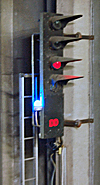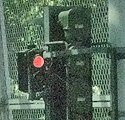Helsingin metro, opastimet
The semaphores and signals of the Helsinki metro
Metron opastimet ja opasteetSeuraavassa opastimia ja niiden opasteita, joita tavallisella metromatkalla voi nähdä. Opastimien tunnukset alkavat Hakaniemen asetinlaitealueella kirjaimella A tai B, Herttoniemen alueella C tai D, Kontulan alueella F tai G ja Vuosaaren alueella H tai L. Metrovarikolla tunnukset ovat E (eteläpuoli), P (pohjoispuoli) ja K (koestusraide). Toinen kirjain on järjestyksessä annettu, esim. A-AB-AC-AD jne. |
The semaphores and signals of the metroBelow are some semaphores and their signals to be seen during a regular metro trip. The semaphore signs start in the Hakaniemi switchover area with the letter A or B, in the Herttoniemi area with C or D, in the Kontula area with F or G and in the Vuosaari area with H or L. At the metro depot, the signs are E (south), P (north) and K (testing track). The second letter has been given in alphabetical order, e.g. A-AB-AC-AD etc. |








